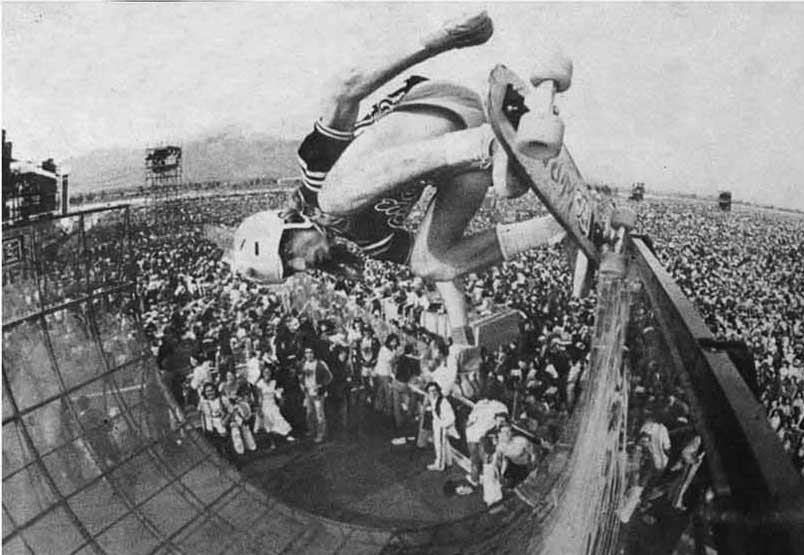The ‘Worm’ inducted into skateboarding hall of fame

Kevin “Worm” Anderson is inducted into the Skateboarding Hall of Fame last week, with a picture of one of his exploits right behind him. Photo by Ian Logan
Much of Kevin Anderson’s best skating happened with few to no people there to see it. Anderson recalled going to the “vertibowl” at the Paramount Skatepark in the 1970s. To this day it is considered one of the largest and deepest skatepark bowls ever constructed. But 70 percent of the time, Anderson estimated, he would be skating it alone.
“People would come there, see it, and the fear would just make them get back into their cars and turn away,” he said.
Anderson was inducted into the Skateboarding Hall of Fame last week in a ceremony at the Globe Theater in downtown Los Angeles. Anderson, known to many by his nickname “Worm,” has been a mainstay at ET Surf for more than four decades. But his entrance to the hall came from his pioneering contributions to vert skating, something that friends and colleagues say may not always be evident from his humble demeanor.
Cindy Whitehead, a Hermosa native and fellow member of the skateboarding hall of fame, still stops by ET frequently, and marvels at how Anderson talks shop.
“He’s always so encouraging of the next generation. Sometimes it’s intimidating to go to skate shops, but not with him,” she said. “They may or may not know who he is. He’s got his own model board hanging right behind him, and he’s telling the kid, ‘Yeah that board’s gonna be sick for you!’ He was a big deal back in the day, but he’s not resting on his laurels. He’s part of what people want when they go in there. He’s the real deal.”
ET, Anderson recalled, emerged from Greg Noll Surfboards, which like other legendary Hermosa shapers was bankrupted by the “shortboard revolution” in 1969. As surfer Mike Purpus related in a 2017 Easy Reader story, Eddie Talbot and Pat Ryan used the proceeds from selling Noll’s leftover resin to backyard shapers to fund their new shop. Anderson got hired at 15 as a “shop grom,” and in the beginning, his job was mostly “to grab Eddie’s lunch,” Anderson recalled.

Anderson shows off his love of vert in front of thousands of onlookers at California Jam in 1974. Photo courtesy Kevin Anderson
Once the shop itself started doing well, Talbot and Anderson went into the skateboard business. The revolution in surfboard design that helped create ET was paralleled by changes in skateboard technology, especially the development of urethane wheels.
“From there it just exploded,” Anderson recalled.
Anderson’s skating is inspired by a desire to push limits of height and speed. He introduced technical innovations, like his tail drops in vertical situations and his switch stance riding, but, “it was all about the bigger the better.”
“I always said, You gotta get high to get high: the higher you go vertically more of a rush,” Anderson said.
Anderson said he was honored to be selected for the hall. But, like fellow ET stalwart Pat Ryan at the Hermosa Surfers Walk of Fame, he acknowledged some head scratching about why he hadn’t made it in sooner. He had, he said, mentored several people who have already been inducted.
The early ‘70s skateboarding scene in the South Bay did as much as any to translate the radical maneuvers of shortened surfboards onto concrete, and then pushed them into the air, amid a surplus of drained pools and, later, a boom in skate park construction. But, as Anderson and others have argued, it got overshadowed by the Zephyr skate team from Santa Monica and Venice, whose exploits were documented in the hugely popular documentary “Dogtown and Z-Boys.”
“I think what happened is, Dogtown got their information around. They weren’t even around in the very earliest days,” Anderson said of the years just after ET opened. “But they ran ads in every magazine there was. And the magazines basically said, If you don’t run ads in our mag, we’re not going to show your pictures. I think that’s part of the reason I never got any recognition for what I did.”
The delay in recognition doesn’t bother him too much though. Throughout his career, Anderson has embraced the thrill, and fear, that skating can provide, without thinking about too much else, often shunning the competitions where others made their name.
“I enjoyed skating with the company I had; I didn’t have to go looking for people. That’s probably why I didn’t get into the competition scene. I was not there to impress. I was there to skate,” he said.

